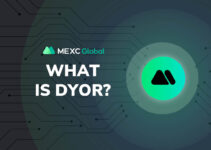Crypto prices have been exploring new lows for weeks and currently it’s unclear what it will take to reverse the trend. Despite the downtrend, cryptocurrencies within the Polkadot (DOT/USDT – Trade it here) ecosystem began to rally on May 24 and have managed to maintain gains ranging from 10% to 25%, a possible sign that certain sub-sectors of the market are on the verge of a breakout.

What Is Polkadot (DOT)?
Polkadot is an open-source sharded multichain protocol that connects and secures a network of specialized blockchains, facilitating cross-chain transfer of any data or asset types, not just tokens, thereby allowing blockchains to be interoperable with each other. Polkadot was designed to provide a foundation for a decentralized internet of blockchains, also known as Web3.
Polkadot is known as a layer-0 metaprotocol because it underlies and describes a format for a network of layer 1 blockchains known as parachains (parallel chains). As a metaprotocol, Polkadot is also capable of autonomously and forklessly updating its own codebase via on-chain governance according to the will of its token holder community.
Polkadot provides a foundation to support a decentralized web, controlled by its users, and to simplify the creation of new applications, institutions and services.
The Polkadot protocol can connect public and private chains, permissionless networks, oracles and future technologies, allowing these independent blockchains to trustlessly share information and transactions through the Polkadot Relay Chain (explained further down).
Polkadot’s native DOT token serves three clear purposes: staking for operations and security, facilitating network governance, and bonding tokens to connect parachains .
Polkadot has four core components:
- Relay Chain: Polkadot’s “heart,” helping to create consensus, interoperability and shared security across the network of different chains
- Parachains: independent chains that can have their own tokens and be optimized for specific use cases
- Parathreads: similar to parachains but with flexible connectivity based on an economical pay-as-you-go model
- Bridges: allow parachains and parathreads to connect and communicate with external blockchains like Ethereum
What Makes Polkadot Unique?
Polkadot is a sharded multichain network, meaning it can process many transactions on several chains in parallel (“parachains”). This parallel processing power improves scalability.
Custom blockchains are quick and easy to develop using the Substrate framework and Substrate blockchains are designed to be easy to connect to Polkadot’s network. The network is also highly flexible and adaptive, allowing the sharing of information and functionality between participants. Polkadot can be automatically upgraded without the need for a fork in order to implement new features or remove bugs.
The network has a highly sophisticated user-driven governance system where all token holders have a vote in how the network is run. Teams can customize their own blockchain’s governance on Polkadot based on their needs and evolving conditions. Nominators, validators, and collators all fulfil various duties to help secure and maintain the network and eradicate bad behavior.
At the end of 2021, Polkadot successfully concluded its first Parachain auctions. The Parachain auctions followed an un-permissioned candle auction system. The winning bid is the highest bid at the random moment the auction ends.
Polkadot assigned the first five slots to the following auction winners: Acala, Moonbeam, Astar, Parallel and Clover . These projects will have their parachain slots locked in for 96 weeks, guaranteed by the DOT bidders committed as collateral. As customary on Polkadot, all projects had previously been battle-tested on its de-facto testnet Kusama.
DOT Token
Following the network’s redenomination after a referendum on Polkadot, DOT balances increased by 100, so one old DOT was equivalent to 100 new DOT. This meant that the initial maximum supply of 10 million old DOT in August 2020 became 1 billion new DOT tokens. The redenomination was undertaken purely to avoid the use of small decimals and make calculation easier. While all balances were increased by a factor of one hundred, this did not impact the distribution of DOT or holders’ proportional share.
Polkadot’s first initial coin offering (ICO) was held in October 2017, and the Polkadot price was $0.29, with 2.24 million tokens offered. The second ICO was held in July 2020, and the Polkadot price offered was $1.25, and 342,080 DOT tokens were sold.
How Is the Polkadot Network Secured?
The network uses an NPoS (nominated proof-of-stake) mechanism with validators and nominators.Nominators back validators with their tokens. These staked tokens maximize chain security by making it prohibitively expensive to misbehave.
Validators are staked on the Relay Chain and confirm transactions coming from the different parachains. This unique validity scheme enables chains to interact with each other securely under the same rules, yet remain independently governed.
Interested in tokens like DOT?
MEXC constantly searches for new moonshots, keep an eye on our Kickstarter and other listing events – we have more GEMs to come! Moreover, visit altcoins section to find more hot tokes that were listed already. If you would like to know more about crypto trading itself visit MEXC Academy.
Join MEXC and Get up to $10,000 Bonus!



